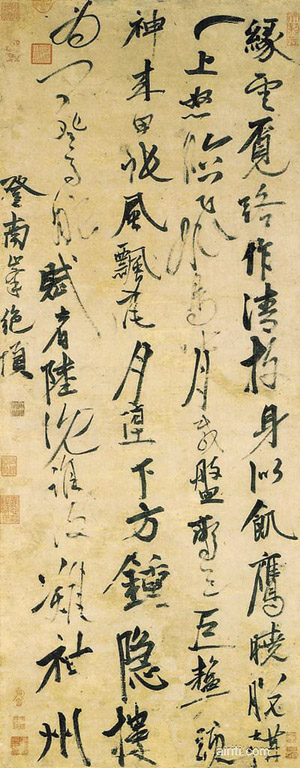Origin and Development of Categories of Calligraphy and Appreciation and Analysis of Calligraphy
Chinese calligraphy consists of five categories of seal script,、clerical script,、cursive script、
running script and regular script,.
Cursive script
Xu Shen, philologist of the Eastern Han dynasty (date of birth and death unknown) says, “Han rises and cursive script emerges.” The “cursive script” according to him refers to semi cursive script. Semi cursive script, spurred by the need for speed writing in clerical script, is a form of calligraphy facilitating writing with ease and speed. It preserves the feature of the wild goose’s tails of clerical script while changing the angular turning point into a round one. In terms of layout, each word is independent with no coherence between each other.
There is a belief that Zhang Zhi of the late Han dynasty (during the reigns of Emperor Ling and Emperor Xian of Eastern Han dynasty) took away traces of clerical script from semi cursive script, turning the wild goose tails as a stroke’s finish that echoes with the character’s interior. Between characters in upper and lower positions run the power of the brush. Typefaces’ size and shape grow at their own wish. As such, the so-called “cursive script” came into being. The simple figure of cursive script allows the lines to express their vitality in greater informality. This linear momentum is an important aesthetic aspect in the appreciation of cursive script.
Cursive script has received strong attention from calligraphers since its birth. The Configuration of cursive script has been completely developed, particularly following the development of the Jin dynasty’s literati, including the father-and-son of Wang Xizhi (321-379, another saying is 303-361) and Wang Xianzi (344-386), setting the standard for cursive script. After the Jin dynasty, the mode of cursive script basically was bound by the system of Wang’s father-and-son. Apart from Wang’s, there are major cursive script calligraphers in each dynasty, including Zhi Yong of the Sui dynasty (date of birth and death unknown), Sun Guoting (date of birth and death unknown) , Zhang Xu (date of birth and death unknown) , Huai Su (725-785)of the Tang dynasty, Mi Fu (1051-1107), Huang Tingjian(1045-1105), Zhao Mengfu(1254-1322), Zhang Yu(1283-1350), Zhu Yunming(1460-1526), Wen Zhenming(1470-1559), Fu Shan(1606-1684)and Wang Zhuan(1623-1709).
*Selected Works
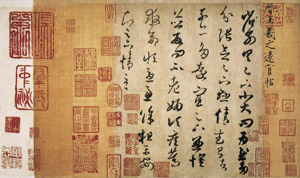 |
|
| Yuan Huan Tie. Wang Xizhi, Jin dynasty |
Yuan Huan Tie demonstrates a handsome use of brush. Mightiness runs through the whole text while the relaxing mood is able to be maintained. Wits over manipulating the size and weight of characters are observed. The brushes form the structural skeletons which lay out spaces of varying degrees of compactness. This work expresses the fluidity and grace which characterize Wang’s calligraphy.
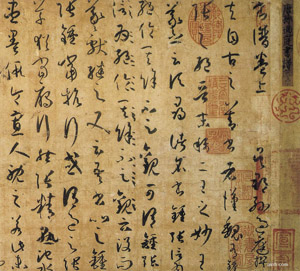 |
|
| Books of Calligraphy. Sun Guoting, Tang dynasty |
Books of Calligraphy is Sun Guoting’s master work, well received in the flow of history, which also crystallizes his theory on calligraphy. Of the over three thousand and five hundred characters in the whole text, not a single one is indolent, which is indeed a relfection on the substantiality of Sun’s basic training; the whole text is an orchestra of climaxes and falls which are in turn connected by one force; and, the beginning and the end are tied in a circle. This work appears as a matter of spontaneity, nevertheless, it has not gone astray from the right track.
 |
|
| Monologue Model Calligraphy. Zhang Xu, Tang dynasty |
Zhang Xu was born to enjoy wine. There is story about him always writing when drunk, soaking his hair in ink, thus, he is known to the world as “Zhang the lunatic.” Zhang’s cursive script is best known for its “wildness”. The “wildness” is realized in the unrestrained and uncontrolled state of his mind and countless variations in his use of the brush, the combination of words and the handling of layout, as well as his expressive power with a potential for exaggeration and wild wandering. The masculine high power of Monologue Model Calligraphy generates an uninhibited running of spirit, allowing Zhang to attach his heart to his work, evoking overwhelming emotions.
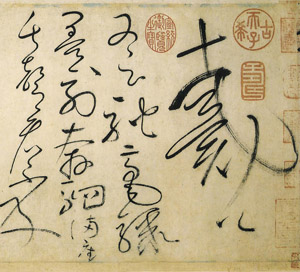 |
|
| The Autobiography Model Calligraphy. Huai Su, Tang dynasty |
Huai Su was also greatly interested in wine. His inspiration came when he was drunk and then he put down his art quickly. He was known to his contemporaries as “wild monk”. And the names of mad cursive script and Zhang Yu go along hand in hand.
His most highly acclaimed work is The Autobiography Model Calligraphy, an essay in which Huai Su narrated his achievement over the learning of calligraphy. Throughout the whole piece runs an air of dignity and passion as well as wildness. He used his brush with ease. It seems that the rise and fall of Huai’s emotion in moving his brush can be felt. This style of ultimate freedom and self-consciousness became the icon for cursive script.
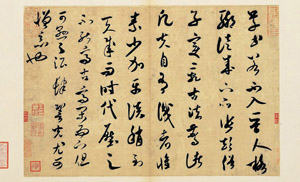 |
|
| Calligraphy on Calligraphy. Mi Fu, Northern Song dynasty |
Mi Fu’s behavior was driven by his self-centeredness. He is known as “eccentric Mi.” Nevertheless, he invested a lot of hard work in studying the calligraphy of ancient times. Brushes of Mi Fu exert great strength. Calligraphy on Calligraphy is Mi’s commentary on cursive script. He argued that cursive script by people of the Jin dynasty is the best while those of the Tang show inadequacy. The style of this piece inherits that of one of the father-and-son of Wang Xizhi’s , fully showing Mi Fu’s theory and practice.
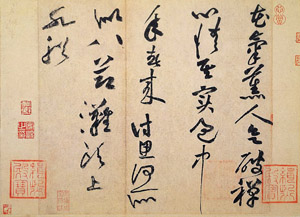 |
|
Scented by Fragrance Model Calligraphy. Huang Tingjian, Northern Song dynasty |
Huang Tingjian’s cursive script followed Zhang Xu, Huai Su, etc. His cursive script shows ambition and radiates outward in full scale; the combination of words changes without prediction and strikes in outrageous pose; condensed rigidity glides along his lines which fly. Scented by Fragrance Model Calligraphy is Huang’s representive piece of wild cursive script. His use of the brush is applied with strength and his ink is applied in a spectrum of effect of richness, moistness and aridness. This is an exceptional piece.
 |
|
| Copying Seventeen Model Calligraphy. Zhao Mengfu, Yuan dynasty |
Zhao Mengfu was adept at every style of calligraphy.. A great amount of his work circulated with his running script circulating the most. And quite unexpectedly, pure cursive scripts became rare. His cursive script was modeled after Wang Xizhi’s Seventeen Model Calligraphy. This Copying Seventeen Model Calligraphy shows his supreme mastery over the calligraphic style of Wang. At the same time, it carries the elegance of Zhao’s calligraphy and aesthetic view about the revival of ancient calligraphy.
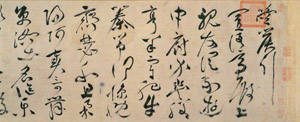 |
|
Miscellaneous Calligraphic Poems Model Calligraphy. Zhu Yunming, Ming dynasty |
Zhu Yunming’s wild cursive script draws particularly great attention. His works have artistic charm. The ever restless brushes, rebellious typefaces and layout arranged in complementary use of sparse and dense spacing, come together to form a piece reminding one of a passionate musical score. His work is in line with Zhang Yu, Huai Su and Huang Tingjian.

